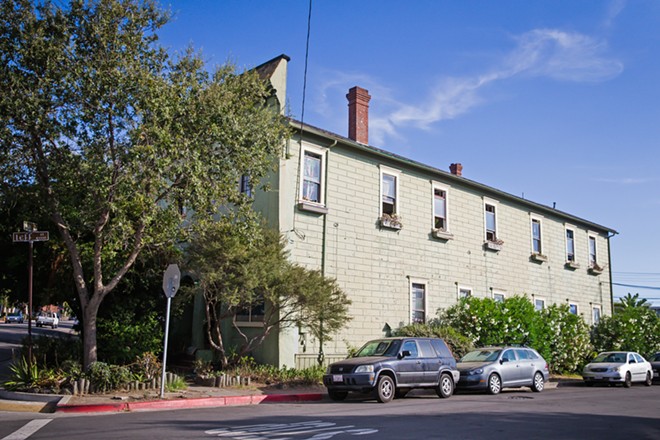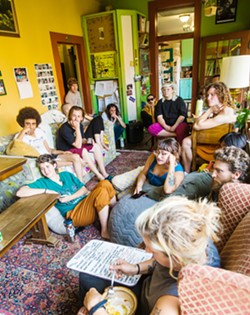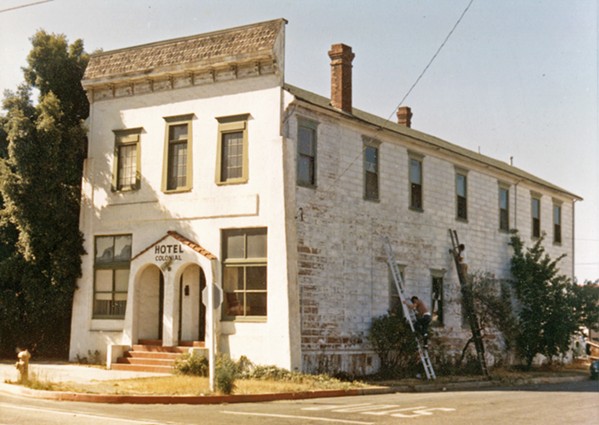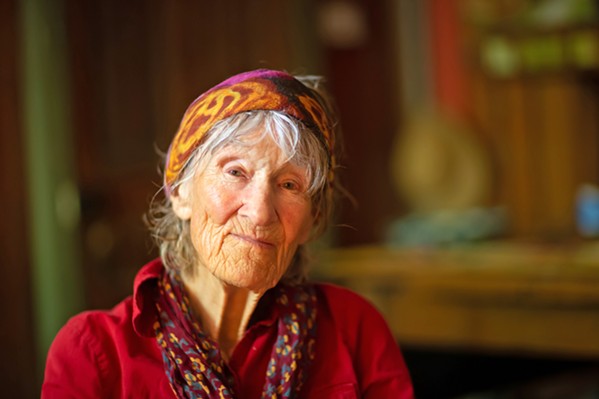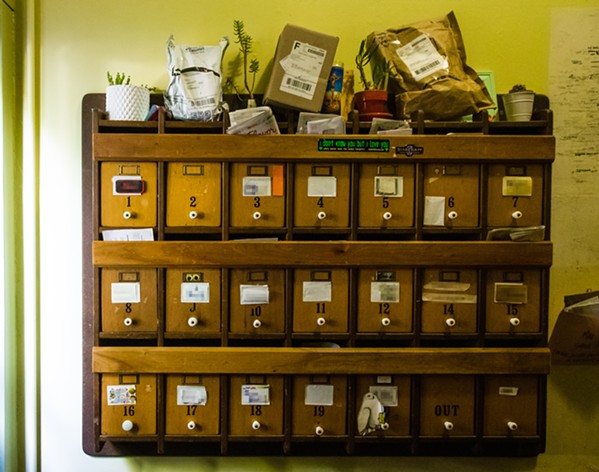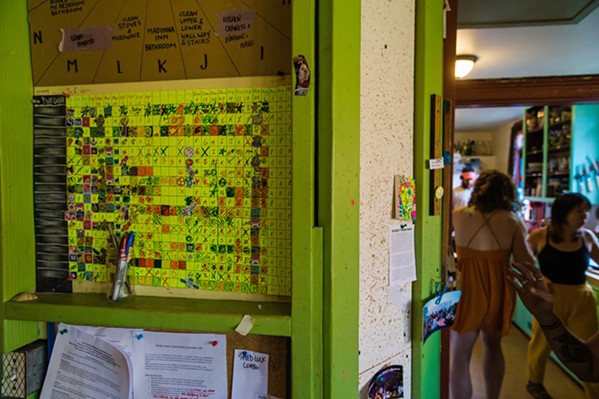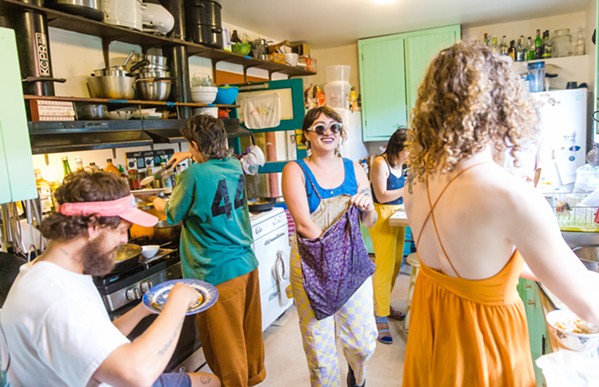Saving community: The Establishment went up for sale this year, leaving stabbies, super stabbies, and extended community members worried about what it might become
By Kylie Mendonca[{
"name": "Ad - Medium Rectangle CC01 - 300x250",
"id": "AdMediumRectangleCC01300x250",
"class": "inlineCenter",
"insertPoint": "8",
"component": "2963441",
"requiredCountToDisplay": "12"
},{
"name": "Ad - Medium Rectangle LC01 - 300x250",
"id": "AdMediumRectangleCC01300x250",
"class": "inlineCenter",
"insertPoint": "18",
"component": "2963441",
"requiredCountToDisplay": "22"
},{
"name": "Ad - Medium Rectangle LC09 - 300x250",
"id": "AdMediumRectangleLC09300x250",
"class": "inlineCenter",
"insertPoint": "28",
"component": "3252660",
"requiredCountToDisplay": "32"
}]
Writer's note: I'm not remotely unbiased about The Establishment. As a journalist, I have to disclose that I lived there off and on between around 2006 and 2015. Some of the people quoted in this story are my friends. As a former housemate, I'm emotionally, though not financially, invested in the house's continuation.
On a cool Saturday evening in July, a woman in black lingerie repelled down the side of a two-story house, clinging to an emergency fire ladder as she stripped, sexy-danced to music, and mugged for a cheering audience in the yard below.
Talent shows at The Establishment, a historical 19-bedroom home in the Railroad District of San Luis Obispo, rarely involve such talent. Indeed, the few children present were more impressed by the "History of The Establishment" told by sock puppets, a more typical talent show offering.
The occasion for this spectacle was a reunion. Former residents from the past 50 or more years were invited back to the house to reminisce and rekindle friendships. The reunion was all the more poignant, as members of The Estab tribe feared this reunion could be the last.
For decades, The Establishment has been a refuge for students, creatives, outcasts, professionals, or anyone seeking an affordable alternative living situation in SLO. It's been an incubator for local businesses, nonprofits, and cultural movements within the city. For the hundreds of people who called it home, it's been a catalyst for personal transformation and the source of lifelong friendships.
In early 2022, The Establishment's longtime owners, headed by matriarch Sara McEre, announced they were selling the house. Residents fretted about the future. Would they be evicted? Would the rent go up? Would the house be demolished and replaced with upscale condos? Would the community survive?
McEre's family alerted the broader Establishment community of their desire to sell before publicly listing the property, in case, by some miracle, the housemates could cobble together enough money to buy it. Current housemates, aka "stabbies," and former housemates, aka "super stabbies," sprang into action. Within days of the announcement, Cal Poly professor, super stabbie, and former Establishment manager Jenn Yost was raising money and trying to set up dinner with other former housemates to discuss a group purchase.
"I consider the loss of that house a huge loss for the whole world, and I'd like to spend my time now trying to save it," Yost said in a Feb. 10 email.
By May 9, according to zillow.com, the house was listed for $2.2 million. No deal had been reached between owners and housemates. Soon, potential investors were stopping by to view the property, creating a sense of unease for many housemates. Emily "Willy" Wilson, current house manager, said what housemates feared was "a total shift in the function of this structure."
"At first," Wilson said, "it was like this is definitely going to be turned into a boutique hotel. And those fears evolved as more people came to see the house, but it all centered around what this house will become."
In May, one housemate, named "Mars," wrote in her farewell email to the group that The Establishment was the first house in which she ever felt "truly safe."
"The feelings of security have been uprooted," she continued. "I'm no longer able to tune out the reality of the house being sold and the resulting feelings of powerlessness. This situation is dysregulating for all of our nervous systems—secure shelter is one of our most basic needs."
At its most basic, the house is a giant 120-year-old rectangle with 19 bedrooms. They line two hallways; one upstairs, and one downstairs, connected by a set of curved stairs that one former housemate called "mezcal-soaked," as they were frequently used for impromptu "stair parties" in her era. The house has few common spaces: There's a community kitchen and a common living room or "den." There are four themed bathrooms—the longest running theme being the Steve Irwin Memorial Bathroom—which are shared by 19 housemates. There's a yard with a wisteria-covered porch, a seating nook, and a shared garden. That's it.
The house's influence is impossible to quantify, and in the spring of 2022, it felt acutely threatened.
Visionaries and the new 'Establishment'
Before The Establishment was The Establishment, it was one of SLO's many flophouses during the 1960s and 1970s.
In the 1950s it was a functional boarding house called the Colonial Hotel or Hotel Colonial, and Jack Kerouack lived there around 1953. By 1964, however, the house was in disrepair—and bankruptcy, according to county documents. There were holes in the floors, made by years of wear from old metal bed wheels. The house already leaned heavily, since the foundation was damaged in the 1920s.
Former SLO County Supervisor Kurt Kupper moved into that house in 1968. He described a no-rules proto-Establishment with two radical architecture professors at the helm. Harvey Koehnen and R.L. Graves purchased the house in 1964. Graves, who served as a SLO City Council member, according to his Cal Poly obituary, initiated the downtown tree planting program and improved pedestrian access downtown. He was also an original Mardi Gras Krewe member. Koehnen was one of three faculty advisors overseeing construction of the Shell House in Cal Poly's architecture gardens the same year he purchased The Establishment house.
Graves came up with the house name, according to Kupper.
"It was supposed to be a declaration of the new establishment," Kupper said, describing a culture that was remarkably similar to what exists today, only wilder. "I don't think we had rules, particularly."
There were parties, pranks, casual sex, disastrous romances, and a strong sense of community. Just like today. There were 21 bedrooms then instead of 19, and the kitchen was half as big. Some rooms had double or triple occupancy (a practice rarely allowed in the modern Establishment) and one even had a great dane living in it.
Most of the housemates were Cal Poly architecture students, and Kupper, who lived in a large room downstairs with his wife and two young kids, was older than most.
"It was a home for us," Kupper said. "I couldn't have afforded to live in SLO otherwise. It allowed me to feed my family and go to school. And it was a fun place for my little boys. They were adopted by the house."
Kupper said the house was "very experimental." One housemate, he recalled, built a giant sphere inside their room. Graves and Koehnen installed the first lofts, just big enough for a full or queen bed in most of the rooms. Those lofts still exist.
Kupper knew it was time to move out when his 3-year-old knew how to use a cigarette lighter. Housemates had taught the boy to say "light my fire," Kupper recalled, laughing.
The modern Establishment is the creation of Sara McEre, a self-professed "architecture junkie" who was unable to attend architecture school, she said, because she's a woman.
I met McEre when I was working as a not-very-good waitress at Louisa's Place, probably 15 years ago. Early one morning, she took a seat at the bar near the back of the restaurant and unloaded a pile of hardcover art and architecture books, newly purchased from a yard sale. A striking woman with messy gray hair and a knotted bandana keeping it at bay, McEre had a slight build and was wearing a loose chambray oxford with rolled sleeves. She ordered coffee, poached eggs, and salsa.
I'm not some breakfast waitress savant, and I don't remember anyone else's order from 15 years ago, except for a group of cantankerous old guys who only ordered coffee daily, 15 minutes before the restaurant was even open, and a guy nicknamed "Dog Bite," who always ordered milk.
But McEre stood out to me.
With help from her parents, McEre bought The Establishment in 1977. She was reeling from the unexpected death of her son, Ben Beauchamp. At only 19 years old, he had died from Crohn's disease that year. McEre was devastated, but when she saw an ad in the paper for a "21-bedroom fixer-upper," she saw an opportunity to channel that grief into something new.
"That's why my parents came up with the money," McEre said. "They didn't want to come up with the money, but they did. They took out a loan. It was out of kindness."
McEre moved into the house part time and hired tradesmen to fix the place up. She added more lofts to rooms, repainted, tried to rehab the old double-hung windows, and restored the wood finishes. Then she started filling the house with people.
Richard Goldsmith moved in during the summer of 1978. He called that era the "Wild West" because there were no rules, no chores, and there wasn't any cultural cohesion.
"The place was really spiffy when I moved in," Goldsmith said. "There was new carpet. The woodworking and the [handmade wood] mailboxes were just beautiful. It was all integrated, and every edge was rounded. Sara had painted all the rooms in neutrals. It wasn't nearly as eclectic as it is now. It looked very sharp and clean. ... Nothing was leaking at that point, or rotting at that point."
After the major repairs were complete, McEre, as a landlord, had a light touch, according to several former managers. Her approach was to let the house culture develop organically. By 1980, the community was starting to take shape. House manager Cecelia Lobdill, nee Ceraceras, created the "chore wheel," signaling the end of the Wild West era and the coming of civilization.
"After a while," McEre said, "they were running it really well."
In 1980 or 1981, the house had its first big themed Halloween party. Residents, many of whom were architecture students, decorated the outside of the house as a giant Winnebago. There was a bumper on the front of the house, and windows became headlights. Giant wheels and a "W" were added to the side of the house. From there, parties and themes became more elaborate.
The house has been a Greek temple, a BDSM playground, a post-apocalyptic hellscape, and a Suessian storybook, among dozens of other themes. Year after year, housemates stapled black plastic to the walls, turned stairs into slides, installed dance poles, and partied until the cops were called. McEre rarely intervened.
She's been known to stop by the house with a bottle of wine and hang out in the den or the backyard. She's an octogenarian not out of place among housemates 60 years her junior, utterly unfazed by changing social norms. For McEre, the secret to hanging on to the community she loves has been to let go of control.
"I used to hang out with the people in The Establishment," McEre said of her time living in the house. "Then one night, at this split second, this guy looked at me as an authority figure. And I thought I have got to get out of here. ... There can't be any authority."
What's at stake?
The house is no longer polished in the ways Goldsmith remembered. But the rent has remained "affordable" by SLO standards. Many super stabbies would point to that affordability as a key driver of the house's culture and impact on the broader community.
Mark "Gizmo" Grayson moved into the house in 2015, but he has been closely associated with The Establishment for more than 20 years. Among other things, Grayson is the creator of the Bike Happening, a monthly party on wheels in downtown SLO. He said stabbies were among the first cyclists to join the party and brought early momentum to the event.
"A lot of creative people in the community have to spend all their time making money to make rent," Grayson said. "But if the rent is affordable, it frees you from the drudgery and allows you to make art."
Grayson pointed out that many stabbies work in the nonprofit sector, or do volunteer work in the community, because they can afford to. One nonprofit, the Bike Kitchen, sprang directly from The Establishment.
Around 2008, three stabbies bought some tools and a bike trailer, rented some storage space, and started fixing bikes for free. Brant Haflich, then a 20-year-old Cal Poly student and former Establishment manager, had the idea to start Bike Kitchen, but the community support and networking centered in The Establishment gave the idea wheels.
Grayson, for example, helped get the first storage space. Former house manager Dan Kallal and others in the Tall Bike Posse gave the Bike Kitchen its first physical space (in an actual kitchen) during their bike month art show. When the Bike Kitchen was a bimonthly guerilla event happening at Mitchell Park, housemates would show up every other weekend to teach bike maintenance skills, to move tools by bike, or just grill hot dogs and hang out.
Housing economist Skylar Olsen agreed with Grayson's evaluation that lower rent enables people to be more creative. Stable housing, she said, is a basic need that must be met before people can access their creative potential. Olsen moved into The Establishment around 2007, as a slam-poetry-reading undergrad with an uncanny gift for explaining economic concepts. Today, Olsen is chief economist for Zillow Group. Affordability, she said, is only half the story.
"I think there are probably two aspects," Olsen said of the house's impact. "There's affordability, and there's this incredible networking effect when you have 19 people working together."
The Bike Kitchen now has a permanent home in a city-owned building, paid staff, and the same mission: To get more people on bikes and teach bike maintenance skills.
Other notable projects to come out of The Establishment include organic bakery Bread Bike and the Tierra Nueva cohousing development in Oceano, which was founded by Lobdill and three other former Establishment housemates.
As a cultural institution, The Establishment connects housemates to other cultural institutions too. If, for example, one housemate works for the county elections office, then the whole house is more aware of local political events and more likely to engage. If one housemate works at a music venue, housemates are more likely to see live music.
"I think something that's super special about the house," current house manager Wilson said, "is the ability to connect with people from different generations of the house. You already have some common ground."
What many former housemates pointed to as the house's greatest value, however, was the personal growth they and others experienced.
"I think a lot of people were born there," Olsen said of The Establishment. "Not really, but metaphorically. One thing I learned there was that life offers you an incredible range of expression and options. You don't always know that, and The Establishment is the place I learned that.
"It turns out that the cost of expressing yourself is very low," Olsen continued. "What is the cost of being embarrassed? The only way to get over being embarrassed is to practice. At The Establishment, you get to practice being whatever you want to be because everyone else is practicing too."
The more things change, the more they stay the same
Housemates going all the way back to the '70s spoke about The Establishment in the same terms: They laughed about old conflicts, they laughed about the ways in which the house infrastructure failed, especially the plumbing—former manager Kallal recalled a recurring "poop lagoon" in the yard—and they talked about what it was like to intentionally share space with other people.
"There's cultural things," current house manager Wilson explained. "I wouldn't call them rules, but there are cultural expectations. One of them is just being willing to engage with other people on more than a superficial level."
For super stabbies, this engagement is what stands out in the rear-view mirror. It's not the big, themed house dinners that happen periodically, but the impromptu dinners that happened when two people bumped into each other in the kitchen.
"When you share refrigerator space with someone," Lobdill said, "you realize that they like the same food, and you just start cooking meals together."
Another side effect of living in an old house with a lot of younger people is that sex becomes an almost public act. It's practically a right of passage for new housemates to emerge in the kitchen at breakfast time and excitedly ask, "Did anyone feel that earthquake last night?"
Shared bathrooms, shared bedroom walls, and shared meals tend to erode the stigma around bodily functions. Maybe it's a defense mechanism, or a response to the ancient plumbing, but poop humor springs eternal at The Establishment. Since around 2005, the house has kept a "poop log" or "diarya" in the bathroom to record any bathroom musings.
So, there it is. The humans at the Establishment eat food, they poop, and they have sex. They also throw great parties.
"If there was a timeline of the house," super stabbie Goldsmith said, "it would go in waves—up and down. It's like people are sort of in a play prescribed by the house. The names change, but the script stays the same. ... There's someone playing you right now. It's sort of like Groundhog Day. It undulates, but the high points sort of look the same."
The third act
Early in the process to save The Establishment, former house manager Yost emerged as the de facto group leader. She organized countless meetings with former housemates to raise money and researched different legal structures for co-ownership. In about two months, former housemates were able to pool together $1.6 million in pledges from approximately 60 people, according to Yost.
They made an all-cash offer that was below the asking price, and McEre's family did not accept it. The group looked for other solutions, but their optimism waned. With the $1.6 million, stabbies could, in theory, buy a different house in SLO and create a new community, just as former housemates had done before with Tierra Nueva, but the idea never took off.
"I think there's some magic in the building itself," Yost said. "Not actual magic, but it's in the layout of the building. The size of the rooms—you can have private space, but they're small enough that you have to come out. ... There are no hidden spaces, so the building promotes interaction. The den is just big enough to have an awesome party, but not too big.
"And I think people also feel differently when they're in a building with some history. You can see the wood floor and think wow, that floor is 100 years old."
In July, McEre's family accepted an offer from a smaller group, composed of former housemates and Establishment supporters, including Yost. As of press time, the house was in a 30-day escrow period.
"I think so many parts of this whole thing have just been so painfully awkward," current manager Wilson said of the sale. "But in the end, I'm stoked. I think this is a great scenario. We had this vision for something really radical, and it seems like that won't happen. But this achieves the ultimate goal, which is to maintain the culture and function of The Establishment."
Yost said that fixing the house would be a priority for the group. It has some foundation problems and deferred maintenance. She said the electrical and plumbing systems need to be updated, and it needs a new roof. Plus, the old windows—the original double-hung windows—are a constant source of frustration.
"I love The Establishment," Yost said. "The culture, the community, but I also love the building, and it's very sad to me how it's deteriorated. I'm excited to usher in a new era, much like Sara McEre must have felt in the '70s.
"I am just really excited that it's going to continue to exist."
Poop Log: a written history in poo haiku, captain's logs, and bodily mishaps
This is a selection of Poop Log entries curated by current house manager Emily "Willy" Wilson. The poop log is a diary kept near the toilet in which people are free to express themselves on all topics, but mostly topics related to poop. The first Poop Log was created by Jenn Yost, circa 2005.
Q: If you could poop at any location in the world, where would it be?
A1: in the egyptian pyramids
A2: in the white house (president's bathroom)
A3: in the president's bed
A4: under the eiffel tower
I used to think my dad was Elvis.
I haven't told him that yet.
I haven't told my dad either.
Q: If you could implement any (new) house rule, what would it be?
A1: 4 hugs a day (that's the minimum)
A2: Weekly group rides
A3: Mandatory Tiger King viewing nights
A4: Conversational Consent
A5: No farting in the kitchen
A6: Eat my ass gently
Q: Where do you see yourself in 5 years?
A: 2025. I live with my partner on a chunk of quiet and lovely land along with 3-6 other households. The COVID vaccine was successful but it gave some recipients the ability to attract stray cats. Bob, next door, can't help but be a beacon for SLO's strays and we have to tell him it isn't working out. There are just too many cats and they have poor boundaries. Last night one of them called me "sweet cheeks." I won't put up with this harassment. Δ
Correction: A previous version of this story misidentified Sara McEre's son and her age. Her son's name is Ben Beauchamp. She is an octogenarian.
Reach contributor Kylie Mendonca through the editor at [email protected].
Latest in News
Readers also liked…
-

Coast Unified teachers upset over new position's salary and qualifications
Oct 20, 2022 -

SLO police identify alleged driver who hit and killed couple
Dec 22, 2022 -

When the levee breaks: Oceano residents, county officials walk a tightrope of regulations to manage Arroyo Grande Creek, which some say led to the levee's failure in January
May 18, 2023

